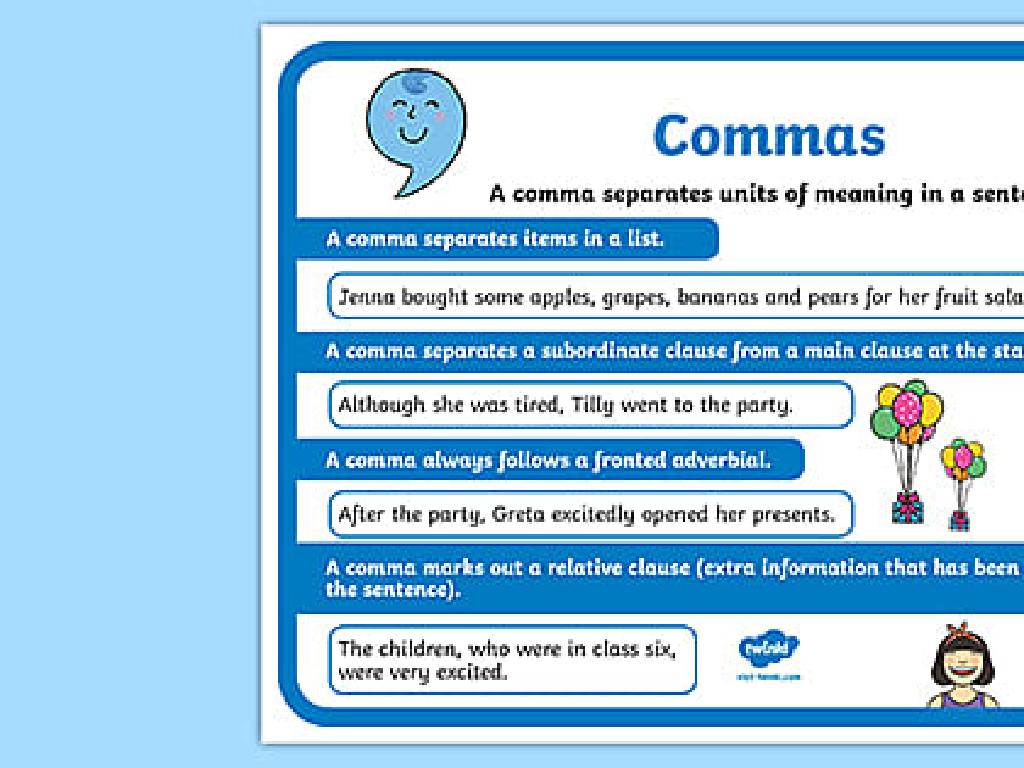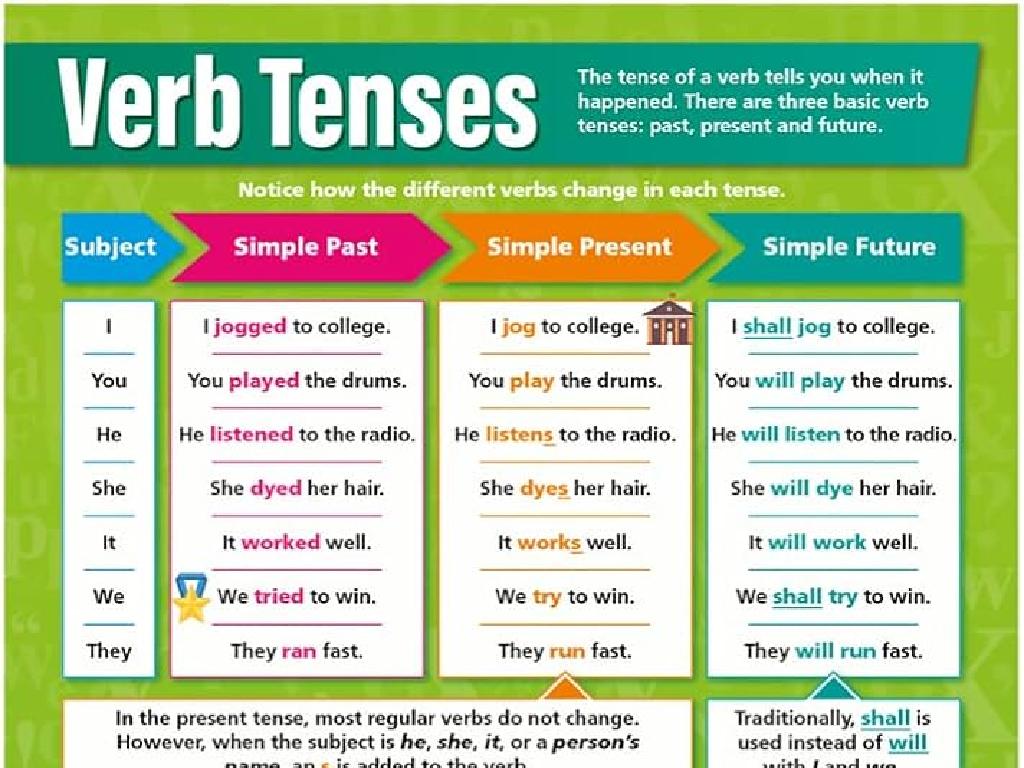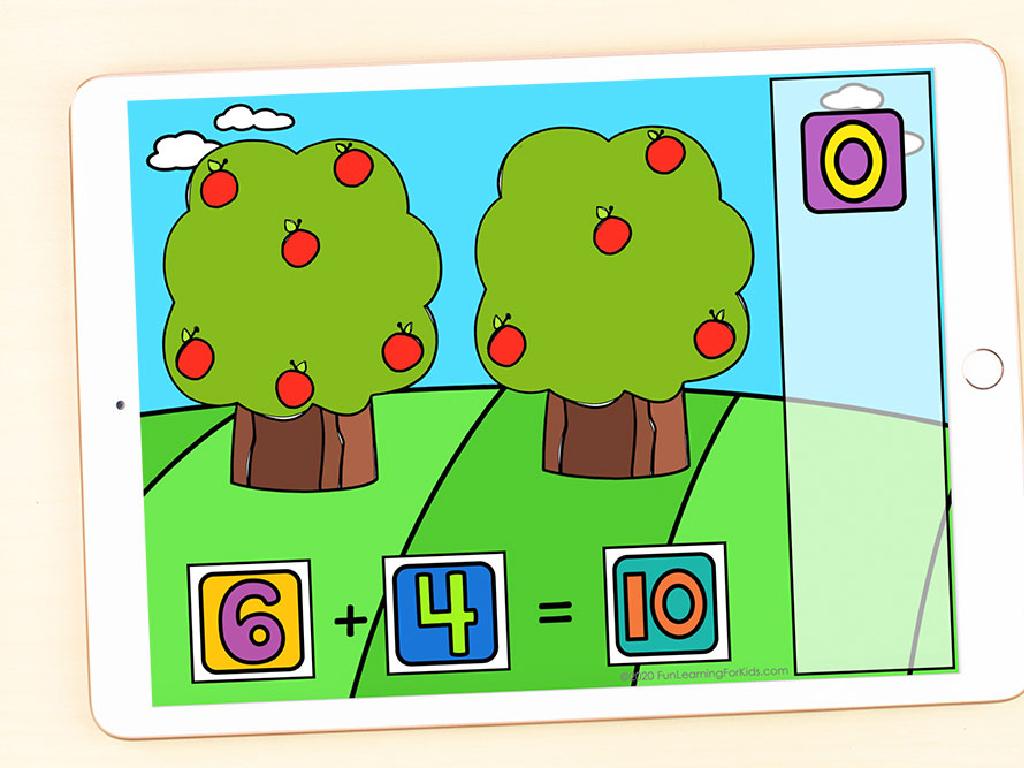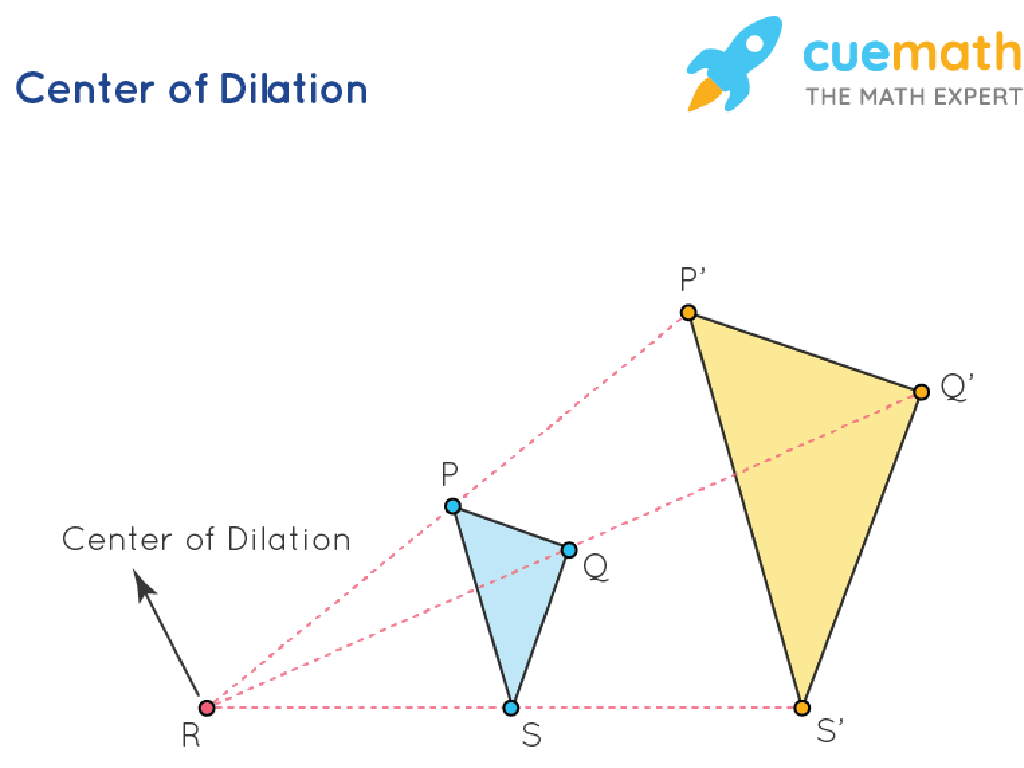Put The Sounds In Order
Subject: Language arts
Grade: First grade
Topic: Blending And Segmenting
Please LOG IN to download the presentation. Access is available to registered users only.
View More Content
Welcome to Blending and Segmenting Sounds!
– Today’s fun: playing with sounds!
– Ordering sounds helps us read
– Sounds make up words, like blocks build a tower
– Be sound detectives
– Find clues in sounds to solve word puzzles
– Listen carefully to sounds
– We ll practice listening to sounds in words
|
This slide introduces the concept of blending and segmenting sounds, which is crucial for developing reading skills in young learners. Emphasize the fun aspect of playing with sounds to keep students engaged. Explain that understanding the order of sounds is like understanding the order of a story. Encourage them to be ‘sound detectives’ by listening for individual sounds in words and figuring out how these sounds blend together to form words. Use simple, familiar words to demonstrate how sounds are blended and segmented. Activities can include listening to words and identifying the first, middle, and last sounds, or having students clap out the number of sounds they hear in a word. The goal is to make them aware of the different sounds and how they come together to create meaning.
Blending Sounds to Form Words
– What is blending?
– Blending combines sounds to create words.
– Blending is like a word smoothie!
– Imagine mixing different sounds to form a tasty word!
– Example: Blending to make ‘cat’
– The sounds /c/, /a/, /t/ mix to say ‘cat’.
|
This slide introduces the concept of blending, a key phonemic awareness skill where students learn to combine individual sounds to form words. Use the analogy of making a smoothie to make the concept relatable and fun for first graders. For example, just like blending fruits to make a smoothie, we blend sounds to make words. Demonstrate with the word ‘cat’, showing how the individual sounds /c/, /a/, and /t/ come together to form the word. Encourage students to practice with different sounds and create their own ‘word smoothies’. This will help them understand how words are formed and improve their reading skills.
Let’s Practice Blending Sounds!
– I’ll say sounds slowly, then faster
– Listen to me blend the sounds
– For example, /c/ /a/ /t/ becomes ‘cat’
– Now it’s your turn to try!
– Repeat after me and blend together
– Practice makes perfect
|
This slide is designed to engage students in a blending exercise, which is a key skill in learning to read. Start by modeling how to say the individual sounds of a word slowly and then more quickly, blending them into the full word. Use simple, familiar words to demonstrate this. After modeling, invite the students to join in and try blending the sounds together with you. Encourage them to listen carefully and repeat the sounds after you, gradually speeding up until they can blend the sounds into words on their own. Provide positive feedback and support as they practice. This activity helps students understand how individual sounds come together to form words, an essential step in developing phonemic awareness.
Understanding Segmenting in Words
– What is segmenting?
– Breaking a word into its individual sounds
– Segmenting is like word cutting
– Example with the word ‘dog’
– ‘dog’ becomes /d/ /o/ /g/
– Practice segmenting together
– We’ll try more words in class!
|
Segmenting is a foundational skill in phonics that helps students understand how words are constructed from individual sounds. It’s important to explain that segmenting is like cutting a word into its sounds, much like how we might cut a string into smaller pieces. Use simple examples like the word ‘dog’ to illustrate the concept, breaking it down into /d/ /o/ /g/. During class, engage students in segmenting activities with a variety of words to reinforce the concept. Encourage them to listen carefully to the sounds that make up words and to practice this skill regularly, as it will aid in their reading and spelling abilities.
Let’s Practice Segmenting!
– Say the word ‘mat’
– Break ‘mat’ into sounds
– ‘m’ – ‘a’ – ‘t’, three sounds
– Count the sounds on fingers
– One finger for each sound
– Practice with different words
|
This slide is designed to help students understand the concept of segmenting words into individual sounds. Start by saying the word ‘mat’ clearly and slowly. Then, demonstrate breaking ‘mat’ into its constituent sounds: ‘m’, ‘a’, and ‘t’. Encourage students to use their fingers to count each sound, which helps with their phonemic awareness. After ‘mat’, practice with other simple words, ensuring each student has a chance to segment and count the sounds. This activity builds the foundational skills necessary for successful reading and spelling.
Game Time: Sound Train
– Build a train with sounds
– Each carriage holds a letter
– Arrange letters in order
– For example, c-a-t becomes cat
– Watch words form as the train moves
|
This interactive game is designed to help first graders understand the concept of blending sounds to form words. Each student will be given letters to create their own ‘sound train’. As they arrange the letters in the correct order, they will see how individual sounds blend to form a complete word. This visual and kinesthetic activity supports phonemic awareness and decoding skills. For the activity, prepare cutouts of train carriages with letters on them. Students can work individually or in groups to form words. Possible variations include using different words, timed challenges, or having students ‘conduct’ the train by reading out the sounds as they connect the carriages.
Class Activity: Sound Puzzles
– Pair up for letter puzzles
– Order sounds to form words
– For example, ‘c-a-t’ makes ‘cat’
– Match words to picture pieces
– Find the picture of a ‘cat’ to complete the puzzle
– Share with the class
|
This activity is designed to help students understand the concept of blending and segmenting sounds to form words. By working in pairs, students can collaborate and help each other arrange letters to create words that match the pictures on their puzzles. Encourage them to sound out each letter and blend them together. After completing a puzzle, have each pair present their word and matched picture to the class, reinforcing their learning and building confidence. Possible variations of the activity could include puzzles with different levels of difficulty, timed challenges, or even creating their own puzzles for peers to solve.
Conclusion: Mastering Sounds
– Excellent work with sound ordering!
– Blending creates words from sounds
– Like puzzle pieces, sounds join to form words
– Segmenting splits words into sounds
– Like a bead necklace, each sound is a bead
– Practice makes perfect
|
Today we’ve learned how to put sounds in order to form words, which is called blending, and how to break words into individual sounds, known as segmenting. These are crucial skills for reading and writing. Encourage the students to keep practicing by using fun activities like sound matching games or breaking apart their favorite words into sounds. Remember to praise their efforts and progress to build confidence. For homework, ask them to find words at home and practice blending and segmenting with their family members.






